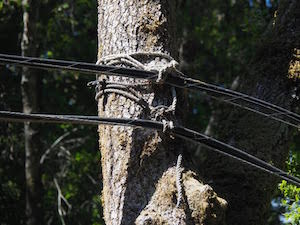
If this looks familiar, you really should take the survey.
If you’ve had problems, or not, completing or receiving a telephone, the California Public Utilities Commission wants to know about it. That includes collect calls and, particularly, calls to 911 or any of its sister services such as 211 (social service referrals) or 811 (underground utility locator, i.e. call before you dig). They also want to know if you’ve “seen conditions with telephone facilities that you believe pose a danger to safety or reliability of communications service (e.g., low hanging wires, wires on the ground, leaning or bent poles, overloaded poles, one pole holding up another, frayed or broken cables, lines attached to trees?)”.
The CPUC put up an online survey a couple of weeks ago, and as of the results posted yesterday evening, six people had responded. They’re posting the comments submitted (with identifying information removed). Six responses isn’t statistically significant, but the trend so far is kinda interesting. Most of the answers amount to no, I haven’t had that problem.
No one is reporting problems with their phone being reported out of service when it isn’t, or with accepting or placing collect calls or with reaching 211 or 811 services. One person had a phone line cut accidentally and another is unhappy with getting out-of-service messages, although based on the comment it might be because the numbers dialled actually are out of service.
On the other hand, two people – both apparently in Tuolumne County – have had problems reaching 911 operators, and three people have seen what they believe to be unsafe pole conditions.
The survey is part of an investigation into rural telephone service reliability being led by commissioner Catherine Sandoval, but the questions being asked in the online survey apply to phone service anywhere in California, and the questions about unsafe or precarious poles, cables and other infrastructure are very relevant to broadband service as well. Poorly maintained legacy phone lines cannot generally deliver even minimum levels of acceptable broadband service. Finding those problems is the first step towards fixing them.
